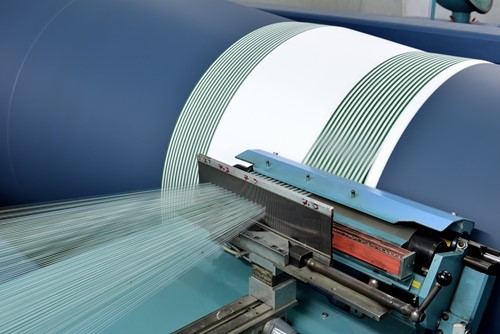Conveyor belts consist of different layers. The fabric reinforced plastic conveyor belts in BTE's range are made up of different fabric and plastic layers. The fabric layers in a conveyor belt form the carcass of the belt. The fabric layers in the conveyor belt are embedded in thermoplastics. The fabric largely determines the properties of a conveyor belt, including, for example:
- The elongation, the longitudinal flexibility. This determines, among other things, the required drum diameter.
- The width stability, the flexibility in the width. For a belt on which heavy objects are transported or a belt where a lot of force is exerted on small surfaces, for example by smaller, relatively heavy objects falling onto the belt, a high width stability is required. In contrast, a tire used in trough form needs high width flexibility.
- Many other properties such as strength, antistatic properties, the degree of stretch and shrinkage, tear resistance, noise behavior, adhesion activity and coefficient of friction.
The properties of the fabric, and therefore the conveyor belt, are determined by the composition of the yarns used in combination with the weave pattern. This blog is a continuation of Tissue to a large extent determines part 1 in which you will find information about the weave pattern, among other things. In this blog I tell a little more about the yarns used for the weave.
Yarns used
The composition of the yarns used also affects the properties of the fabric. This is not only about the material used, but also about thickness of the threads and the way the threads are twined or not. Generally, conveyor belt fabrics are made of monofilament, multifilament or spun yarn.
Monofilament: a single fiber
Monofilament is a homogeneous, extruded thread, i.e. thread consisting of a single fiber. For conveyor belt fabrics, this always involves a synthetic yarn, for example polyamide, better known as nylon. Nylon is a strong material, which does not wear out quickly with friction and is well cut-resistant.
Monofilament is not flexible and is therefore used mainly for the weft direction in the weave pattern (in the width of the fabric). This gives the fabric a higher stiffness and more stability in width. This is important in applications where a high load capacity is required. The tire then continues to run flat even with a heavy load. Another good example of an application for which a belt with high stiffness is suitable is an articulated conveyor belt.
Multifilament: twisted yarn
Multifilament yarns consist of different synthetic yarns, which are twisted together to 1 yarn. Multifilament has a greater tensile strength and is more flexible than monofilament. Multifilament yarn is usually used for the warp (the longitudinal threads in the fabric).
In addition, multifilament is also used for the weft direction (in width). The resulting flexible fabric is pliable in all directions, thus flexible in both length and width, and is used, for example, for trough-shaped conveyor belts.
Spun yarn
Spun yarn is made by twisting plastic or natural fibers together to form long threads. Spun yarn can be used in both the length (warp) and width (weft) directions. Spun yarn of polyester is used, for example, for whisper fabric.
Combinations with other yarns
In some types of fabric, these yarns are combined with other yarns that provide specific properties. For example, a carbon yarn that gives the belts antistatic properties. The static electricity generated by friction between the belts and the rollers or slide plate can be easily diverted when using an antistatic belt. This prevents overshooting sparks (explosion hazard) and shocks to users.
What are the characteristics of my application that place requirements on my conveyor belt?
To ensure that your conveyor belt meets the right properties, the selection of the right conveyor belt fabric is very important. What properties of your application are important when choosing your conveyor belt? And which conveyor belt fits best? Bandtransport Europe can give you excellent advice. I would like to help you! Do not hesitate to contact me via the button below or call +31 (0)251 319 119).
By Jeroen Al

Feel free to contact us. We'll be happy to assist.
Do you want to know more about our products? Contact us for more information or request a quotation.